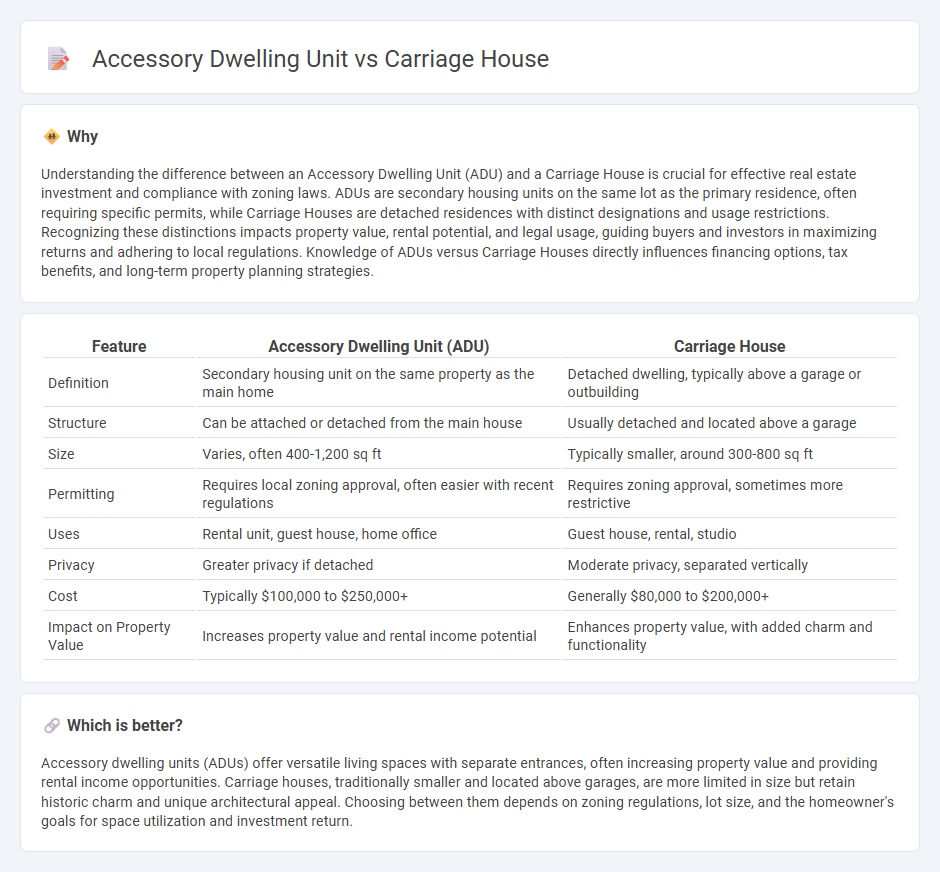
Accessory dwelling units (ADUs) are secondary housing units located on the same lot as a primary residence, often providing affordable and flexible living arrangements. Carriage houses specifically refer to secondary dwellings originally designed as carriage storage but converted into residential spaces, usually featuring a distinct architectural style and separate entrance. Explore further to understand the benefits and distinctions between ADUs and carriage houses in real estate development.
Why it is important
Understanding the difference between an Accessory Dwelling Unit (ADU) and a Carriage House is crucial for effective real estate investment and compliance with zoning laws. ADUs are secondary housing units on the same lot as the primary residence, often requiring specific permits, while Carriage Houses are detached residences with distinct designations and usage restrictions. Recognizing these distinctions impacts property value, rental potential, and legal usage, guiding buyers and investors in maximizing returns and adhering to local regulations. Knowledge of ADUs versus Carriage Houses directly influences financing options, tax benefits, and long-term property planning strategies.
Comparison Table
| Feature | Accessory Dwelling Unit (ADU) | Carriage House |
|---|---|---|
| Definition | Secondary housing unit on the same property as the main home | Detached dwelling, typically above a garage or outbuilding |
| Structure | Can be attached or detached from the main house | Usually detached and located above a garage |
| Size | Varies, often 400-1,200 sq ft | Typically smaller, around 300-800 sq ft |
| Permitting | Requires local zoning approval, often easier with recent regulations | Requires zoning approval, sometimes more restrictive |
| Uses | Rental unit, guest house, home office | Guest house, rental, studio |
| Privacy | Greater privacy if detached | Moderate privacy, separated vertically |
| Cost | Typically $100,000 to $250,000+ | Generally $80,000 to $200,000+ |
| Impact on Property Value | Increases property value and rental income potential | Enhances property value, with added charm and functionality |
Which is better?
Accessory dwelling units (ADUs) offer versatile living spaces with separate entrances, often increasing property value and providing rental income opportunities. Carriage houses, traditionally smaller and located above garages, are more limited in size but retain historic charm and unique architectural appeal. Choosing between them depends on zoning regulations, lot size, and the homeowner's goals for space utilization and investment return.
Connection
Accessory dwelling units (ADUs) and carriage houses both serve as secondary living spaces on residential properties, providing additional housing options without the need for new land development. Carriage houses, historically built above garages or outbuildings, are often converted or designed as ADUs to maximize property value and increase rental income. Both structures support urban densification efforts by offering affordable, flexible housing solutions within existing neighborhoods.
Key Terms
Detached structure
A carriage house is a detached secondary building historically used for horse-drawn carriages, now often converted into living spaces, while an accessory dwelling unit (ADU) is a broader term for any secondary dwelling unit on the same lot as a primary residence, including detached structures. Both serve as separate living quarters but differ in legal definitions, size restrictions, and zoning regulations depending on the locality. Explore detailed comparisons and zoning implications to understand which option fits your property goals best.
Zoning regulations
Zoning regulations for carriage houses and accessory dwelling units (ADUs) vary widely, affecting their eligibility, size, and placement on residential properties. Carriage houses often face stricter rules due to their historical nature and potential impact on neighborhood aesthetics, while ADUs generally benefit from more flexible zoning to address housing shortages. Discover detailed zoning guidelines and how they influence your ability to add these structures to your property.
Secondary residence
A carriage house is a detached secondary residence often located above a garage, providing additional living space without expanding the primary home's footprint. An accessory dwelling unit (ADU) encompasses a broader category, including detached, attached, or interior secondary residences designed to offer independent housing on the same property. Explore key differences in zoning, size, and usage to determine which secondary residence fits your needs.
Source and External Links
Carriage House - A carriage house, also known as a remise or coach house, is originally built to house horse-drawn carriages but often converted for other uses.
The Carriage House - This is a restaurant and pub in Pennsylvania, offering craft beers and modern American cuisine with an Austrian twist.
Carriage House Children's Center of Pittsburgh - Provides a nurturing environment for children, offering childcare services and educational activities.
 dowidth.com
dowidth.com